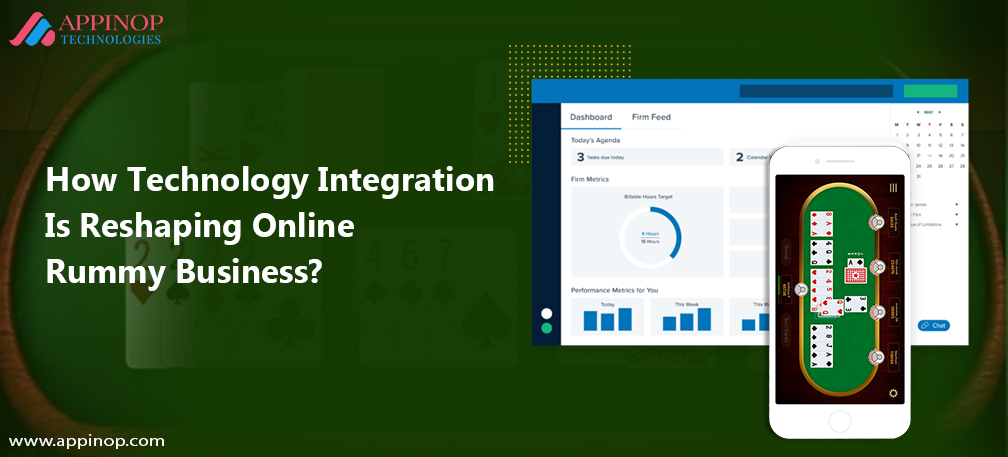
Rummy Game Development Cost: A Complete Guide for 2025
Rummy has established itself as one of the most popular card games, especially in India, where millions enjoy its strategic gameplay and social interaction. The rise of digital technology has transformed traditional rummy into an engaging online experience, allowing players to connect from anywhere at any time. As more players flock to digital platforms, the demand for rummy game development is surging, prompting developers to explore the financial aspects of creating a competitive online rummy game.
In 2025, the landscape of rummy game development will be shaped by advancements in technology, increasing player expectations, and a growing number of competitors entering the market. Understanding the cost of rummy game development is essential for businesses looking to invest in this thriving sector. This guide aims to provide a comprehensive overview of the various factors influencing Rummy game development costs, current market trends, and must-have features that can set a game apart from the competition.
Online Rummy Market Trends: Key Insights and Data for 2025
The online rummy market is witnessing remarkable growth, driven by changing consumer preferences, technological advancements, and increased smartphone penetration. According to industry reports, the online gaming sector in India is expected to reach $3.75 billion by 2025, with rummy constituting a significant portion of this growth.
- Rising Popularity Among Youth: The younger generation is increasingly drawn to online rummy due to its strategic gameplay and social interaction features. As gaming becomes a primary source of entertainment, developers are targeting this demographic with engaging content and user-friendly interfaces.
- Mobile Gaming Dominance: With over 700 million smartphone users in India, mobile gaming is on the rise. Rummy games optimized for mobile platforms are seeing higher engagement and retention rates, leading to an increase in player acquisition.
- Integration of Live Gaming Features: Live gaming experiences, where players can interact with real dealers and opponents, are gaining traction. This trend is enhancing the authenticity of online rummy and providing a more immersive experience.
- Regulatory Changes: The Indian government’s evolving stance on online gaming is impacting the market. Recent regulations are providing a clearer framework, which is encouraging more investments in the sector.
- Emergence of Skill-Based Gaming: Rummy is recognized as a skill-based game, differentiating it from traditional gambling. This perception is driving more players to engage in rummy, as they can apply their skills to improve their chances of winning.
As these trends continue to evolve, developers need to stay updated with market dynamics to create successful rummy games that resonate with players.
10 Factors That Can Impact Rummy Game Development Budget
When planning the development of a rummy game, various factors can influence the overall budget. Understanding these factors is crucial for accurate budgeting and resource allocation. Below are ten key factors that can impact the development costs:
| SR | Factor | Impact on Budget |
| 1 | Game Design Complexity | A more intricate design with advanced graphics, animations, and layouts requires additional resources and time, significantly increasing costs. A simple interface will reduce costs but may not provide an engaging user experience. |
| 2 | Platform Selection | Developing for multiple platforms (iOS, Android, Web) can significantly raise expenses. Each platform requires different coding standards, testing processes, and user interface adaptations, impacting the overall budget. |
| 3 | User Interface (UI) | A polished and user-friendly UI demands higher investment in design and testing. The complexity of the UI can also affect how intuitively players interact with the game, influencing user retention. |
| 4 | Backend Infrastructure | Robust servers and databases for multiplayer features, player data storage, and real-time gameplay can inflate budget requirements. A scalable backend infrastructure is essential for handling peak user loads without compromising performance. |
| 5 | Game Features | Advanced features (e.g., multiplayer modes, chat systems, tournaments) add to development time and costs. Unique features that enhance gameplay may require specialized development, further increasing the budget. |
| 6 | Licensing and Compliance | Obtaining necessary licenses and adhering to regulations can be costly. Ensuring compliance with local laws and regulations regarding online gaming is crucial and can involve legal fees and administrative costs. |
| 7 | Marketing and Launch | Budgeting for marketing campaigns and promotional activities post-launch is essential. A well-planned marketing strategy can significantly affect the game’s visibility and initial player base, influencing long-term success. |
| 8 | Quality Assurance (QA) | Extensive testing for bugs and functionality is critical, requiring more resources. QA is vital to ensure a smooth user experience, and investing in this phase can prevent costly post-launch fixes. |
| 9 | Maintenance and Updates | Ongoing costs for server maintenance, regular updates, and customer support should be factored in. Continuous improvements and content updates are essential for keeping players engaged and retaining their interest. |
| 10 | Development Team Expertise | Hiring experienced developers can increase costs, but can lead to a better-quality product. Skilled developers can navigate potential challenges efficiently, resulting in a smoother development process and a more polished final product. Investing in a knowledgeable team often pays off through enhanced gameplay and user satisfaction. |
Must-Have Features in Your Rummy Game: Top 5 Features

To create a successful rummy game, certain features are essential to enhance user engagement and satisfaction. Here are the top five must-have features:
- User-Friendly Interface: A clean and intuitive interface is crucial for player retention. The design should facilitate easy navigation, making it simple for both novice and experienced players to join games, manage their profiles, and access features.
- Multi-Player Mode: Implementing multiplayer capabilities allows users to play against friends or random opponents, enhancing the competitive aspect of the game. Real-time matchmaking features can improve player engagement by quickly connecting users.
- Secure Payment Gateway: Incorporating a secure payment gateway for transactions ensures that players can deposit and withdraw funds with confidence. This feature is essential for real-money gaming and enhances the trustworthiness of the platform.
- Chat Functionality: Enabling chat features allows players to interact during games, fostering a social gaming environment. This not only makes the experience more enjoyable but also encourages community building among players.
- Reward Systems: Implementing a robust reward system, including bonuses, loyalty programs, and leaderboards, motivates players to return to the game regularly. Offering incentives can increase player engagement and retention rates.
These features not only enhance the gameplay experience but also contribute to the long-term success of a rummy game in a competitive market.
Rummy Game Development Cost in India
The cost of rummy game development in India can vary significantly based on several factors, including complexity, features, and the development team’s expertise. Below is a more detailed breakdown of estimated costs associated with various aspects of rummy game development cost in India:
| Development Aspect | Estimated Cost (INR) |
| Basic Rummy Game | 5,00,000 – 10,00,000 |
| Advanced Features (Multiplayer, etc.) | 10,00,000 – 20,00,000 |
| UI/UX Design | 1,00,000 – 3,00,000 |
| Backend Development | 2,00,000 – 5,00,000 |
| Security Features | 1,00,000 – 2,00,000 |
| Testing and Quality Assurance | 50,000 – 1,00,000 |
| Marketing and Launch | 2,00,000 – 5,00,000 |
| Ongoing Maintenance and Updates | 1,00,000 – 3,00,000 annually |
| Regulatory Compliance | 50,000 – 1,50,000 |
| Customer Support Infrastructure | 1,00,000 – 3,00,000 |
| Total Estimated Cost | 12,00,000 – 56,00,000 |
Breakdown of Costs:
- Basic Rummy Game Development Cost: The initial investment for a basic rummy game Development cost usually ranges between INR 5,00,000 to 10,00,000. This typically includes the fundamental gameplay mechanics, a simple user interface, and basic multiplayer functionalities.
- Advanced Features: Incorporating advanced features such as live dealer options, enhanced graphics, and additional game modes can significantly increase the budget, often ranging from INR 10,00,000 to 20,00,000.
- User Interface (UI) and User Experience (UX): A well-designed UI/UX is crucial for player retention. Expect to invest INR 1,00,000 to 3,00,000 for professional design services that create an engaging and user-friendly environment.
- Backend Development: A robust backend is essential for supporting multiplayer functionalities, real-time data processing, and player accounts. So backend rummy game Development cost between INR 2,00,000 and 5,00,000.
- Security Features: With online gaming involving real money, investing in security features is vital. This includes encryption, secure payment gateways, and anti-fraud measures, typically costing around INR 1,00,000 to 2,00,000.
- Testing and Quality Assurance: Thorough testing ensures the game is bug-free and provides a smooth experience. This can add another INR 50,000 to 1,00,000 to your budget.
- Ongoing Maintenance and Updates: After the game’s launch, maintenance and regular updates are essential for long-term success. Annual costs can range from INR 1,00,000 to 3,00,000, depending on the game’s complexity and the frequency of updates.
- Regulatory Compliance: Ensuring that your game adheres to local laws and regulations may involve legal fees and compliance measures, costing between INR 50,000 and 1,50,000.
- Customer Support Infrastructure: Implementing a customer support system for player queries and issues can range from INR 1,00,000 to 3,00,000, depending on the support level you wish to offer.
These estimates are indicative and can fluctuate based on the specific requirements of the project. Investing in quality development and features can yield better user engagement and retention, ultimately resulting in higher profitability.
Summary
Understanding the rummy game development cost structure is crucial for developers and businesses aiming to enter this growing market. By breaking down the costs into various components, potential developers can better prepare their budgets and ensure they allocate resources effectively throughout the development process.
Conclusion
As the online rummy market continues to grow, understanding the Rummy game Development costs involved in game development is crucial for aspiring developers and businesses. By considering the various factors that impact budgets, the essential features required for a successful game, and current market trends, developers can make informed decisions that enhance their chances of success in this competitive landscape. As we move into 2025, those who embrace innovation, prioritize user experience, and maintain robust marketing strategies will be well-positioned to capitalize on the thriving online rummy market.
Check out Latest Instagram post on Rummy Game Development.
FAQs
Question 1: What is the average cost of developing a rummy game in India?
The average rummy game development Cost ranges from INR 12,00,000 to 46,00,000, depending on features and complexity.
Question 2: How long does it take to develop a rummy game?
Development timelines can vary but typically range from 3 to 6 months.
Question 3: What features should I include in my rummy game?
Must-have features include a user-friendly interface, multiplayer mode, secure payment gateway, chat functionality, and reward systems.
Question 4: Is it necessary to have a mobile version of my rummy game?
Yes, with the growing number of mobile users, having a mobile-optimized version is essential for reaching a broader audience.
Question 5: What factors influence the rummy game development Cost?
Factors include game design complexity, platform selection, features, licensing, and the expertise of the development team
Appinop Technologies
We are a closely knitted bunch of thinkers, designers, developers and investors who are committed to transform the user experience by inventing and reinventing techniques that return high user engagement and increase share ability. Be it Android or iOS Mobile App or an Ecommerce portal, we strive to deliver only the best even if it takes repeated revisions.










